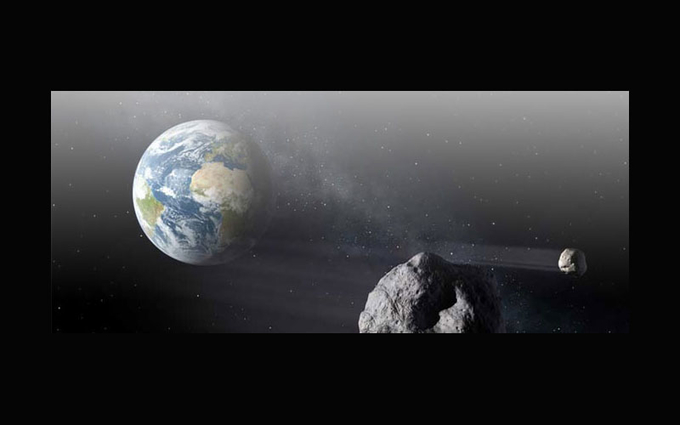Janus Laser Furthers Planetary Defense Research
Defending Earth against incoming asteroids—uncommon but potentially catastrophic threats—is no easy task. Without convenient, cost-effective ways to experiment directly on asteroids in the solar system, scientists run simulations and conduct high-energy-density experiments on asteroid fragments with lasers. Those who need to study matter under extreme conditions find a willing partner in the Laboratory and its high-power laser capabilities at the Jupiter Laser Facility (JLF).
Among the solutions to impending asteroid threat is a method of deflection known as kinetic impact, which involves crashing an unmanned spacecraft into an asteroid to nudge it off its trajectory. Planetary defense researchers at Lawrence Livermore have been working with NASA and other entities toward a proposed mission known as DART (Double Asteroid Redirection Test) in which a moonlet of the asteroid Didymos will become the target of a full-scale kinetic impact experiment. Physicist Laura Chen from the University of Oxford is working with Livermore scientist Megan Bruck Syal, who is among DART’s collaborators.
Recently Chen traveled to Livermore to lead a multidisciplinary team in experiments on rare meteoritic samples, or space rocks, which were collected from North America, Africa, and Antarctica. Her objective was to quantify the rocks’ strength responses to inform asteroid deflection simulations. “How strength varies between materials or even between samples of a single material is important to understand, as often the material and microstructure of the asteroid cannot be known without a rendezvous mission,” explains Chen. Her experiments also support research in other deflection methods, such as nuclear ablation, as well as planetary impact simulations.
The Laboratory helped Chen fund, staff, prepare for, and conduct the experiments. She explains that Livermore’s target fabrication, optics polishing, and computer simulation expertise “allow for ease of access to set up and run an experiment.” With a long history as a premier user facility, JLF provided her with Janus, a kilojoule-class, neodymium-glass laser system, and the resources to use it. As a repeat facility user, Chen says, “I always enjoy working with the JLF staff.”
Chen’s team performed more than 200 shots with Janus, in which the laser was varied in time to provide a strong, specifically shaped compression wave in the samples. First, the rocks were cut and polished into hundreds of tiny targets approximately 100 micrometers thick. To help benchmark the simulation codes with the presumed mineralogical makeup of asteroids and planetary bodies, other targets were created from idealized mineral compositions. Then the team fired 10-nanosecond ramp pulses at varying energies, from 20 to 150 joules, to measure each target’s strength and recovery reactions. Janus’s VISAR (Velocity Interferometer System for Any Reflector) diagnostic capabilities enabled the team to gauge each sample’s strength through observation of particles that move or eject from the target during a shot. Following these experiments, the next step is to sort through the data and work on the equation of state of the material.
Chen’s experience in Livermore has helped her pay forward similar opportunities to other young scientists. “I very much appreciate that JLF can be a training ground for students and postdocs. I spent a lot of time there working on my Ph.D. and conducting these experiments,” says Chen. She was able to bring in two postdoctoral staff and two Ph.D. students to assist with the project, which she co-led with Livermore physicist Damian Swift. Their team included colleagues from the Engineering, Weapons and Complex Integration, and Physical and Life Sciences directorates as well as researchers from Imperial College in London, Michigan State University, and the University of California at Berkeley. “We had a great group of people working on this,” notes Chen. “The work would not have been possible without all of them.”
Learn more: A BBC video describing asteroid deflection includes footage of JLF.
– Holly Auten








